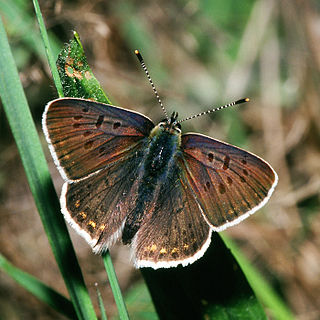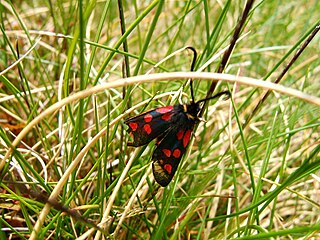
The red underwing is a moth of the family Erebidae. The species was first described by Carl Linnaeus in his 1767 12th edition of Systema Naturae.

Apatura iris, the purple emperor, is a Palearctic butterfly of the family Nymphalidae.

The ringlet is a butterfly in the family Nymphalidae. It is only one of the numerous "ringlet" butterflies in the tribe Satyrini.

Zygaena transalpina is a moth of the family Zygaenidae.

Zygaena is a genus of moths in the family Zygaenidae. These brightly coloured, day-flying moths are native to the West Palearctic.

Zygaena carniolica, sometimes described as the crepuscular burnet or eastern burnet, is a member of the family Zygaenidae.

Zygaena ephialtes is day-flying species of burnet moth found in Europe. It is typically found in xeric habitats, and populations have recently decreased. It also exhibits Müllerian mimicry with other species, like Amata phegea.

Pyrrhia umbra, the bordered sallow, is a moth of the family Noctuidae. The species was first described by Johann Siegfried Hufnagel in 1766. It is found in all of Europe, east through Anatolia to Iran, Afghanistan, Pakistan and Nepal and through central Asia to Japan. In mountains it can be found up to elevations of 1,600 meters.

Lycaena tityrus, the sooty copper, is a butterfly of the family Lycaenidae. It is found in Europe.

Zygaena exulans, the mountain burnet or Scotch burnet, is a moth of the family Zygaenidae.

Zygaena lonicerae, the narrow-bordered five-spot burnet, is a moth of the family Zygaenidae. The species was first described by Theodor Gottlieb von Scheven in 1777.

Zygaena purpuralis, the transparent burnet, is a moth of the family Zygaenidae.

Zygaena occitanica, the Provence burnet, is a moth of the Zygaenidae family. It is found from the Algarve and southern Spain up to the eastern parts of the Cantabrian Mountains then to southern Russia and the Caucasus and east to the western fringe of Central Asia.

Zygaena sarpedon is a moth of the Zygaenidae family. It is found in France, Italy and on the Iberian Peninsula.

Zygaena brizae is a species of moth in the Zygaenidae family. It is found in France, Italy, Austria, the Czech Republic, Poland, Slovakia, Hungary, the Balkan Peninsula, Moldova, Ukraine, Russia, Turkey and Georgia.

Zygaena punctum is a species of moth in the family Zygaenidae. It is found in Poland, the Czech Republic, Slovakia, Austria, Slovenia, Italy, the Balkan Peninsula, Moldova, Ukraine, Russia and Turkey.

Zygaena anthyllidis is a species of moth in the Zygaenidae family. It is found in France and Spain.

Zygaena rhadamanthus is a species of moth in the Zygaenidae family. It is found in France, Spain, Portugal and Italy.

Zygaena marcuna is a species of moth in the Zygaenidae family. It is found in Morocco, Algeria and Tunisia. It is dull red or dark pink. The black dot situated in the distal area touches the black costal margin, and the red basal area is separated from the red discal area by a heavy black band. It was described from the Aures Mountains from specimens found in May.The larval host plants are Ononis natrix and Ononis repens. Imagines fly in May and June.

Zygaena felix is a species of moth in the Zygaenidae family. It is found in south Spain and the Atlas Mountains. In Seitz it is described. — In felix Oberth., from Algiers and South-West Spain, the black spots are more or less confluent, the red ground-colour along the distal margin being sometimes separated as a sock-like halfmoon. The white edges are usually altogether absent, or there are only feeble vestiges of them — In ab. faustula Stgr.-Reb.[ now Z. felix ssp. constantinensis Reiss & Tremewan, 1964] on the contrary the black spots are distinctly edged with yellowish white. — Lastly, ab.mauretanica Stgr. [now Z. felix ssp. constantinensis Reiss & Tremewan, 1964] (8a) has a red belt. — The 3 forms tly exactly at the same time and the same places; I found them frequently united in copula. They are extremely common throughout June on nearly all the heights of the Atlas Mts., sometimes the one sometimes the other form being prevalent in the various flight-places.




















